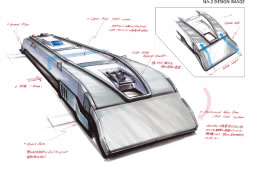 |
|
|
 
Something caught our attention as we continued our cushion research;
when a spring is compressed, reaction force occurs; when the spring
is stretched, its resiliency works to return it to its original form.
In other words, force in one direction creates reaction force in the
other direction. However, a stable state of equilibrium does occur
between the load mass and spring force in which no reaction force
is created; we call this state "Spring-zero".
This state of stability occurs at a given point, but if it can be
expanded across a certain area rather than confined to one point,
that area can be linked to an absorption (damping) force against an
applied force.
Magnets have an N-pole and an S-pole; it is widely understood that
drawing opposite poles together causes an attractive force, and bringing
the same poles together creates repulsion force. This repulsion force
closely resembles a spring.
In other words, if an attempt is made to bring them closer together
than a specific distance, repulsion forces them apart. On the other
hand, when they are drawn apart, there is no resiliency to bring them
back together. For that reason, the contour of the magnets and combination
of poles were designed to combine with metal springs to create a reaction
force at either pole that returns the mechanism to its original state.
The area of motion toward either pole is the state of "spring-zero"-the
area in which a state of equilibrium is maintained. This is the fundamental
design theory behind the magneto-spring.
The first problem that must be solved in order to realize this design
is the reaction force (magnetic force). It takes a very strong magnet
to simulate the reaction force of a spring.. The "neodymium magnet"
fits the bill.
These magnets possess a magnetic force so strong that once stuck together,
it is very difficult to pry them apart by hand. There are even instances
in which fingers have been broken caught between the magnets. The
neodymium magnets clear the required amount of reaction force.
Next is the combination of the magnets.. In order to optimize reaction
force and damping force, vibration tests were performed repeatedly
to further refine the design.. When this fine-tuned magneto-spring
is subjected the reverberations of a shaker table, it exhibits superb
vibration absorption. When a cup of water, full to the brim, was placed
on top of the magneto-spring, during the test, the water surface showed
no motion whatsoever. Being extremely particular about our seats'
cushioning characteristics led to the realization of the world's first
magnetic damper. |
 |
|
